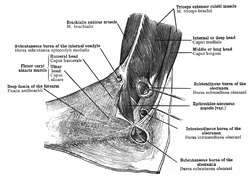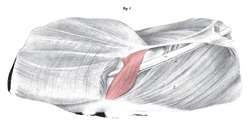Epitrochleoanconeus muscle
The epitrochleoanconeus muscle (anconeous epitrochlearis muscle, anconeus-epitrochlearis or anconeus sextus) is a small accessory muscle of the arm which runs from the back of the inner condyle of the humerus over the ulnar nerve to the olecranon.
| Epitrochleoanconeus muscle | |
|---|---|
 | |
 Illustration of a dissected elbow joint showing ulnar nerve (a), epitrochleoanconeus (1 in red), triceps extensor cubiti (2) and flexor carpi ulnaris muscles (3). From Gruber (1866). | |
| Details | |
| Origin | Inferior surface of the medial epicondyle of the humerus |
| Insertion | olecranon process |
| Nerve | Ulnar nerve |
| Identifiers | |
| Latin | Musculus epitrochleoanconaeus |
| Anatomical terms of muscle | |
Structure
The epitrochleoanconeus is a short striated muscle which originates on the posterior surface of the medial epicondyle of the humerus. The muscle runs over the ulnar nerve, forms an arch over the cubital tunnel and inserts on the olecranon. It is innervated by the ulnar nerve.
Variation
There are cases where there is no structure at all bridging the space occupied by the epitrochleoanconeus.[1]
Prevalence
The prevalence of the epitrochleoanconeus in humans has been estimated to be between 1-30% from various cadaver elbow dissection studies, conversely Osborne's ligament has a prevalence of ~77%.[2][3]
Clinical significance
The presence of the epitrochleoanconeus muscle can lead to ulnar neuropathy, or cubital tunnel syndrome, due to compression of the ulnar nerve.[3][4][5] The absence of epitrochleoanconeus muscle or Osborne's ligament can increase the chances of ulnar nerve dislocation.[1]
History
While there were previous identifications of the epitrochleoanconeus in animal studies, under a variety of names, Gruber (1866) seems to offer the first extensive comparative study involving the epitrochleoanconeus in man.[6] This was shortly followed by several accounts by Wood describing his identification of the muscle during a series of dissections in humans along with comparative studies in other animals.[7][8]
Other animals
In animals with a discrete developed epitrochleoanconeus the muscle acts as an adductor of the olecranon and a supinator of the forearm.[9] A variety of names have been given to this muscle in different species including flexor antebrachii ulnaris, epitrochleo-cubitalis and entepicondylo-ulnaris. The epitrochleoanconius is common amongst tetrapods being found in reptiles, amphibians, mammals and birds.[10]
The epitrochleoanconeus is found widely amongst mammals having been characterised in the mid 19th century in a variety of species including two-toed sloth, duck billed platypus and echidna. Galton (1874) gave an overview of the several species characterised at that point and noted that at least 15 species had been figured with the muscle in Cuvier's "Anatomie comparée" of 1855 but that the muscle was given a wide variety of aliases and was not shown in many species where it should have been seen.[9] The muscle is common in lower primates but has been lost as a discrete muscle in apes, although it has reoccurred in chimpanzees.[9][11]
See also
References
This article incorporates text in the public domain from page 448 of the 20th edition of Gray's Anatomy (1918)
- O'Driscoll SW, Horii E, Carmichael SW, Morrey BF (1991). "The cubital tunnel and ulnar neuropathy". J Bone Joint Surg Br. 73 (4): 613–7. PMID 2071645.
- Dellon AL (1986). "Musculotendinous variations about the medial humeral epicondyle". J Hand Surg Br Vol. 11 (2): 175–81. PMID 3734552.
- Gervasio O, Zaccone C (2008). "Surgical approach to ulnar nerve compression at the elbow caused by the epitrochleoanconeus muscle and a prominent medial head of the triceps". Neurosurgery. 62 (3 Suppl 1): 186–92, discussion 192–3. doi:10.1227/01.neu.0000317392.29551.aa. PMID 18424985.
- Nellans K, Galdi B, Kim HM, Levine WN (2014). "Ulnar neuropathy as a result of anconeus epitrochlearis". Orthopedics. 37 (8): e743–5. doi:10.3928/01477447-20140728-92. PMID 25102512.
- Uscetin I, Bingol D, Ozkaya O, Orman C, Akan M (2014). "Ulnar nerve compression at the elbow caused by the epitrochleoanconeus muscle: a case report and surgical approach". Turk Neurosurg. 24 (2): 266–71. doi:10.5137/1019-5149.JTN.6913-12.0. PMID 24831373.
- Gruber, W. (1866) "Über den Musculus epitrochleo-anconeus des Menschen und der Säugethiere." Mem. de L'Acadèmie Impèriale des Sciences de St. Petersbourg S. 7., 10(5):1-26.
- Wood J (1867) "Variations in Human Myology Observed during the Winter Session of 1866-67 at King's College, London." Proceedings of the Royal Society of London, Vol. 15, pp. 518-546
- Wood J (1868) "Variations in Human Myology Observed during the Winter Session of 1867-68 at King's College, London " Proceedings of the Royal Society of London, Vol. 16, pp. 483-525
- Galton JC (1874). "On the Epitrochleo-Anconeus or Anconeus Sextus (Gruber)". J Anat Physiol. 9 (Pt 1): 168.2–175. PMC 1319039. PMID 17231045.
- Abdala V, Diogo R (2010). "Comparative anatomy, homologies and evolution of the pectoral and forelimb musculature of tetrapods with special attention to extant limbed amphibians and reptiles". J. Anat. 217 (5): 536–73. doi:10.1111/j.1469-7580.2010.01278.x. PMC 3035861. PMID 20807270.
- Diogo R, Richmond BG, Wood B (2012). "Evolution and homologies of primate and modern human hand and forearm muscles, with notes on thumb movements and tool use". J. Hum. Evol. 63 (1): 64–78. doi:10.1016/j.jhevol.2012.04.001. PMID 22640954.